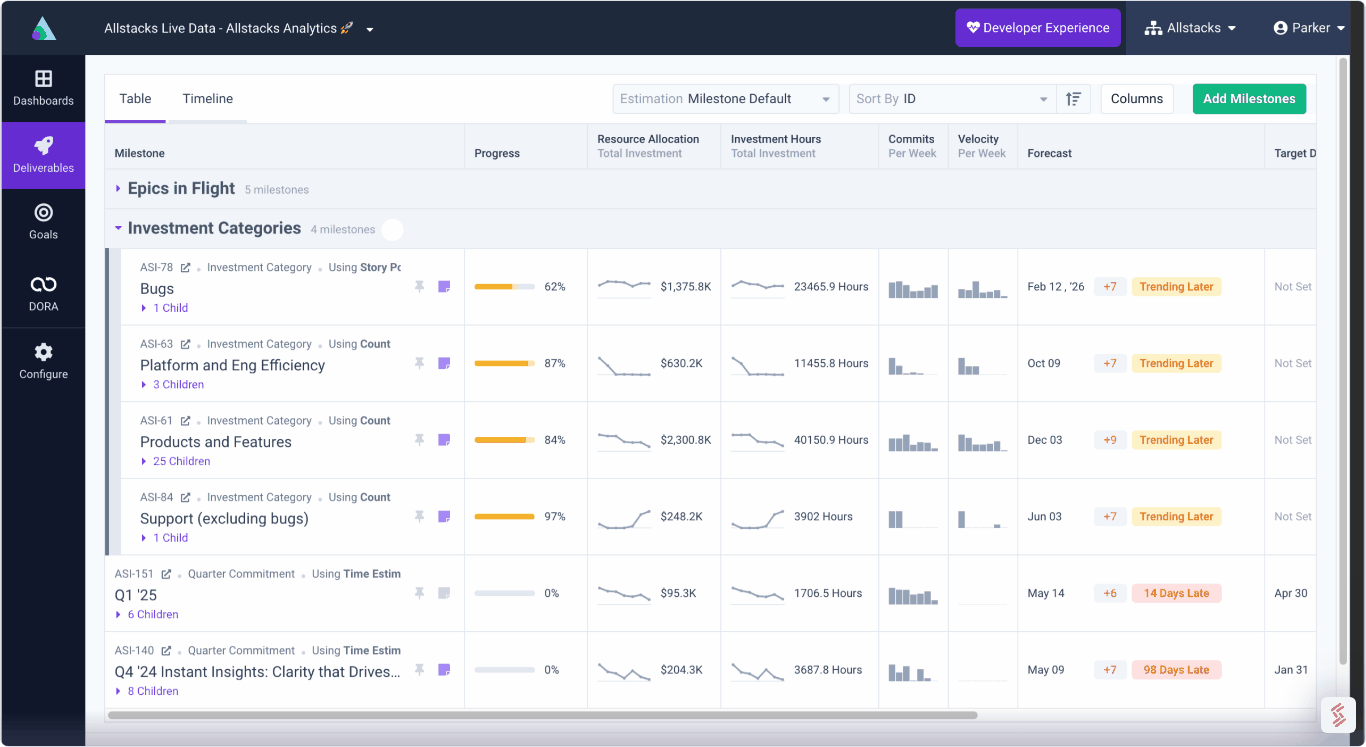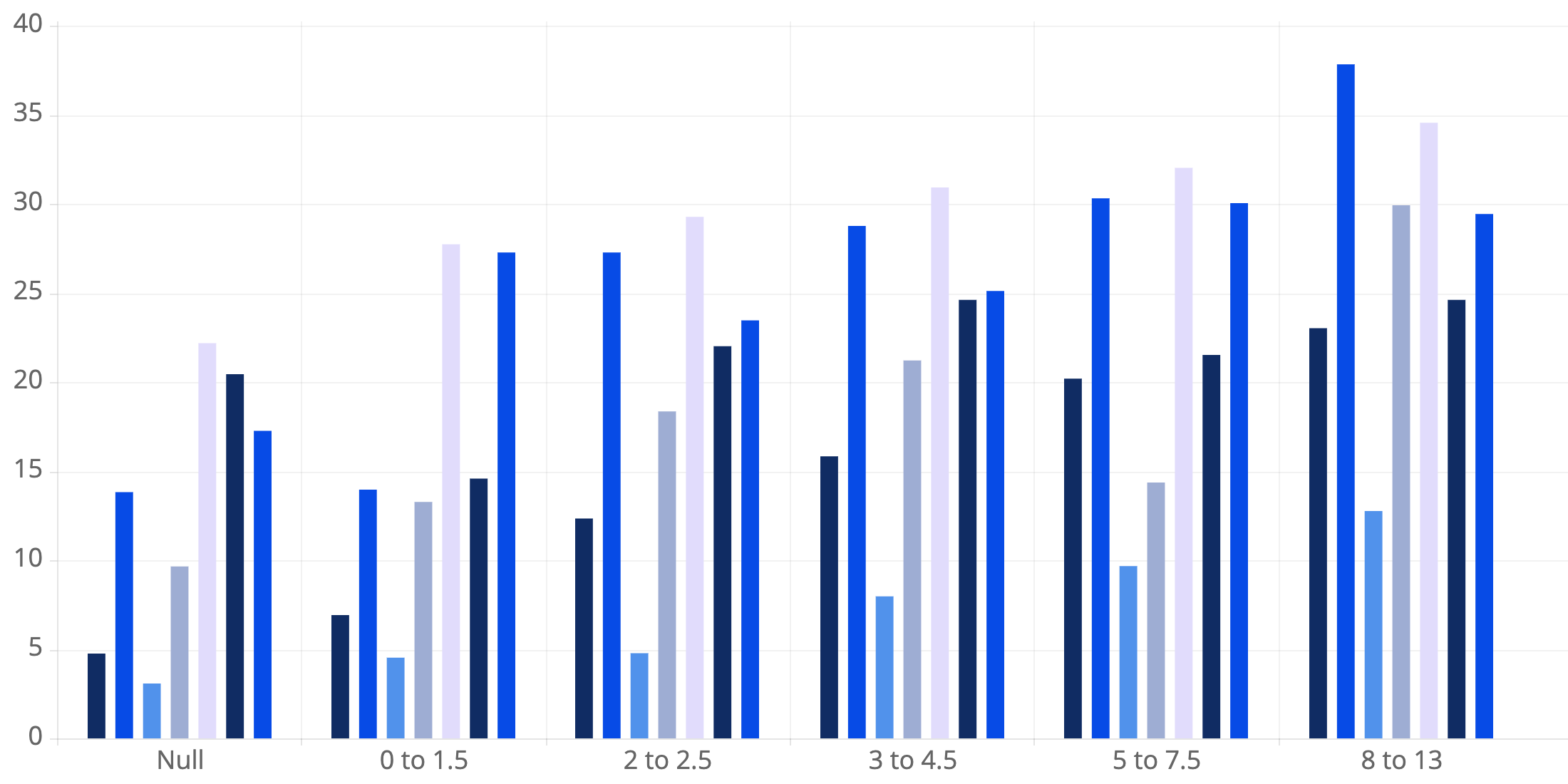.png)
Software Engineering Intelligence
-
Intelligence Engine
On-demand exhaustive AI-analysis
-
Engineering Investment
Complete visibility into time & dollars spent
-
360º Insights
Create meaningful reports and dashboards
-
Project Forecasting
Track and forecast all deliverables
DevEx
-
Developer Surveys
Create and share developer surveys
Software Capitalization
-
R&D Capitalization Reporting
Align and track development costs
Achieving Mastery in Software Delivery: The Path to Predictability and Customer Promotion
At Allstacks, we partner with software organizations to help them mature their development metrics approach and process to achieve a state of mastery in software delivery. This mastery is characterized by a high degree of predictability, minimal incomplete work, and quantifiably improved customer satisfaction.
.png)
The key to overcoming these challenges lies in incrementally maturing your software development metrics processes to achieve mastery level maturity. Identifying, with our customers, the appropriate metrics at each situational stage is what Allstacks is specifically designed to enable.
| Predictability | ||||
| Product Backlog | Balanced Planning | Completion | ||
| Mature State Definitions |
Ideal State: - There is now a 90 day planning horizon with 6 -2 week sprint cycles. - The planning horizon has now been effectively executed for 9-12 months. - The overall goal of the horizon is understood and communicated to both internal stakeholders and customers. Items that are "deprioritized" are equally understood and communicated. - Within the 2 week release cadence (or automated CI/CD pipeline) there is a demonstration of release as planned with minimal incomplete or carryover work increment for the planning horizon. - This will be reflected by a consistently low Churn Rate. - Customer NPS is quantifiably improved with "Predictability" identified by customers as a major contributor to satisfaction. |
There is a published and communicated plan for a balance of: - Innovation (Bold changes to execution over a mid to long make leaps and bounds toward an established customer experience). - Iteration (Incremental changes to the existing product to deliver additional customer value). - Operational excellence (Tooling to support Performance & Scale improvements, Tech Debt, and bug fixes). - This is best represented by sustained target percentage effort for each work type within the 60-90 day planning increment.
|
- A completed state is the only meaningful condition of software. - Consistent horizon (6-9 months) is vital for achieving high degrees of Customer Satisfaction or Net Promoter Score improvement. - Demonstrated and continuous delivery of planned product improvements are key to success in this category.
|
|
**Predictability approach co-developed by Jim Grundner (Allstacks) and Scott Barstow (Pacific Lake Partners).
How we define the journey more broadly:
We recognize that organizations progress through distinct maturity levels on their journey to mastery. Our approach is to first identify your organization's current state or baseline. From there, we work to understand the initial desired improvement goals and outcomes. Based on that information then implement a tailored metrics program to guide your ascent through three key stages: Baseline/Launch, Acceleration, and Mastery.
Baseline/Launch Stage: The Maturity starting point
At initial levels of the maturity journey, we move to an improvement objective called “Baseline/Launch”. In this stage we typically observe frequently changing priorities, often driven by demanding customers or stakeholders. There is little observed accountability for assessing the impact of these changes, resulting in numerous projects being started but never completed. Understanding the current state is vital in setting new behavior goals going forward. The consequences of this approach are severe:
- Unfinished features cannot be monetized, rendering all work done on those features as zero value.
- Frequent context switching breeds discontent and unnecessary stress among teams.
- Lack of disciplined prioritization signals a poor understanding of your product's true value to customers.
In this stage, we collaborate and target 3-5 key metrics to “Launch” in order to achieve some beginning success in measurements and associated improvements over a 3-4 sprint window. In the example below, we see significant work as uncategorized, meaning there is quite a bit going on and we do not know if it ties to strategic initiatives or is “drift’ work. In any case, the goal of 75% tied to Epics is falling very short.
Acceleration Stage: Commitment to Predictability
As your organization matures, you establish informal criteria for when priorities can change and navigate conflicts related to those changes. After executing against agreed-upon priorities for at least six to nine months (3 - 90 day planning cycles), teams become comfortable saying "no" or "not yet" to disruptive changes. The benefits of this intermediate level of maturity include:
- Increased trust in the organization's ability to deliver on commitments, both internally and with customers.
- Time and space for engineering and product teams to plan properly.
- Significantly reduced incomplete work.
- Quantifiable business value creation through improved sales, retention, NPS, or other metrics.
In the chart below, we see the predictability has increased significantly with very little uncategorized remaining and a significant uptick in customer related “Products and Features”. We now see our strategic investment targets in line with actual achievement.
Mastering Software Delivery - Achieving predictability
The ultimate goal is to achieve mastery level maturity, where your organization operates with a high degree of predictability and customer satisfaction. At this stage:
- You have a 90-day planning horizon with 6-2 week sprint cycles that have been effectively executed for 9-12 months.
- The overall goals of the planning horizon are clearly understood and communicated to internal stakeholders and customers. Deprioritized items are equally transparent.
- Within each release cadence (or automated CI/CD pipeline), releases occur as planned with minimal incomplete or carryover work.
- This predictability is reflected in a consistently low churn rate.
- Customer NPS is quantifiably improved, with "Predictability" cited as a major contributor to satisfaction.
In this final chart depicting the achievement of targeted Q2 strategic initiatives - we see all of them are 100% complete, and in fact several ahead of time. The behavior has now evolved from the initial depiction of a relatively chaotic cycle of planning and execution to one of strategic planning and execution we can absolutely and predictably rely on.
This level of mastery takes time and cannot be taken for granted, the diligence has to be continued. With this level of predictable completion, customer expectations can be set and met, resulting in higher product usability and Net Promoter Scores (NPS).
The Business Benefits of Mastery
Achieving mastery level maturity in software delivery unlocks numerous business benefits:
- Increased Customer Satisfaction and Retention: By delivering on commitments consistently and transparently communicating roadmaps, you build trust and loyalty with your customers.
- Faster Time to Market: With a predictable cadence and minimal rework, new features and capabilities reach customers more rapidly, giving you a competitive edge.
- Improved Team Morale and Productivity: Teams operate in a low-stress, high-trust environment focused on delivering value rather than constantly context-switching.
- Better Return on Investment: By eliminating wasteful incomplete work, you maximize the value derived from your development efforts.
While challenging, the journey to software delivery mastery yields immense rewards. Allstacks guides organizations through an incremental metrics based approach of maturing processes, instilling disciplined prioritization, and fostering transparency - empowering you to delight customers and accelerate business success.
Contact us today to Get Predictable!




